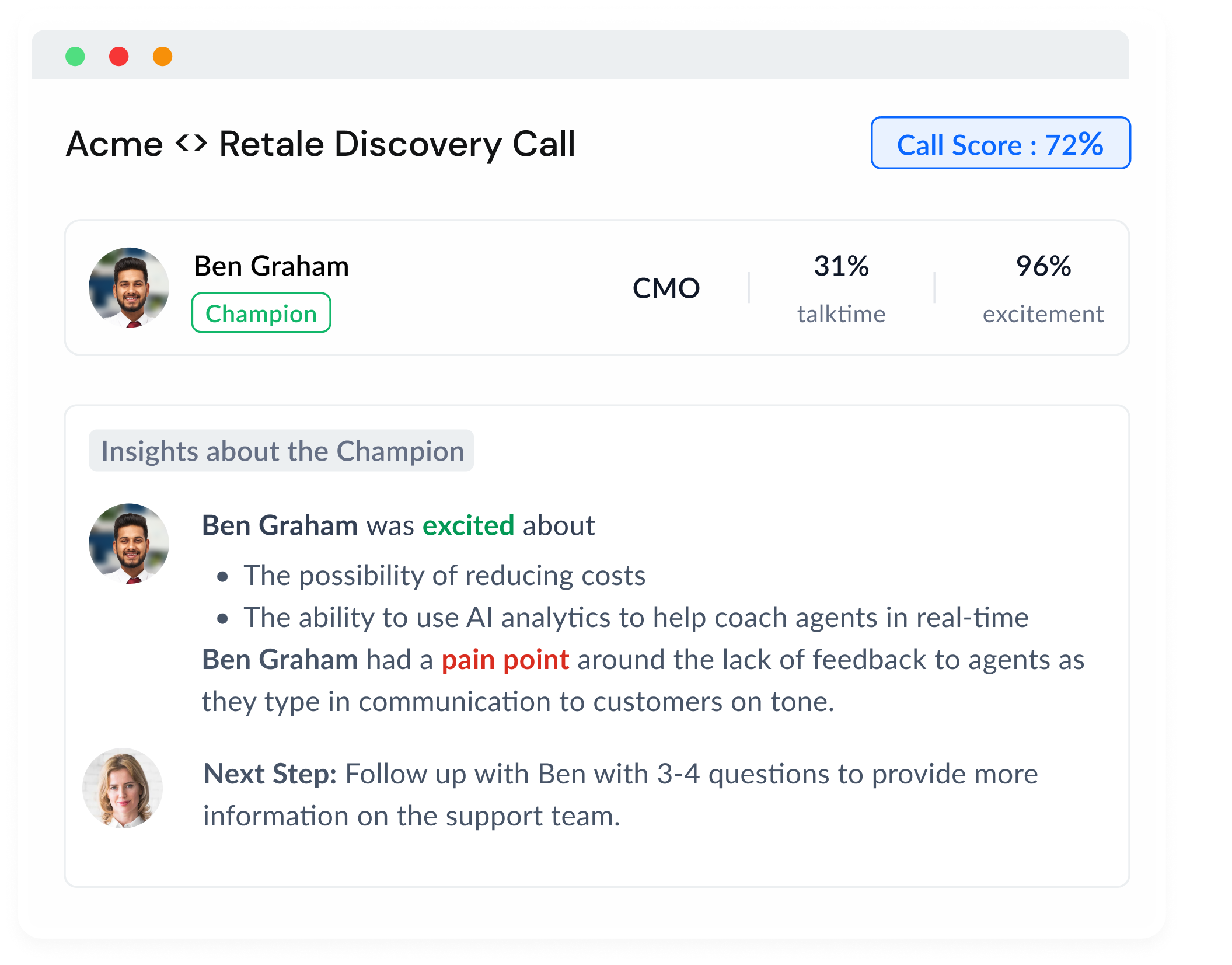The Importance of Communicating Value and Unique Selling Proposition
Imagine walking into a store wanting to buy a vacuum cleaner and the sales rep starts talking about how it has a shiny red color and comes with a long power cord. While those things are great, they haven't exactly sold you on the product. Now imagine the sales rep tells you that it eliminates 99.9% of dust particles from your home, ensuring you and your family breathe cleaner air. Now, that's what we call communicating value.
In today's competitive market, communicating value and articulating a unique selling proposition (USP) can make or break a sale. The ability to showcase how a product or service can solve a customer’s problems and meet their needs is critical to sales success. By understanding your customer and presenting your product in the right light, you can create compelling messages that resonate with prospects and close more deals.
Who Can Benefit from this Guide (Sales Coaches and Reps)
This guide is designed to help sales coaches and reps sharpen their skills and enhance their ability to communicate value and perfect their USP. If you're a sales professional looking to step up your game, you're in the right place. We'll arm you with practical techniques and powerful storytelling tools that will have your prospects nodding in agreement and eagerly reaching for their wallets in no time.
Knowing Your Customer - The Key to Effective Communication
Research, Research, Research!
Social Listening and Industry News
First things first—know your customer. Social listening and monitoring industry news can help you stay informed about the pain points and desires of your target audience. Follow blogs, forums, and social media platforms to get a sense of what customers are discussing, their concerns, and the type of products and services they're seeking.
CRM Data Analysis
Another invaluable resource, especially if you use a smart CRM like Sybill, is digging into your CRM data. Analyze past customer interactions and look for trends to better understand their preferences, needs, and the type of solutions they're looking for.
Assessing Customer Needs - From Pain Points to Goals
Once you've done your research, it's time to shift gears and assess what your customer wants and needs. Ask yourself: What are the primary pain points my product or service can address? How can it help them achieve their goals? By identifying these core issues and aligning your sales pitch with them, you'll be better equipped to communicate value effectively.
Personalization - Making the Connection
Now that you've gathered intel on your customer, it's time to make things personal. No, we don't mean stalking their social media and mentioning their latest vacation in your pitch (please don't). Rather, use your newfound knowledge to tailor your sales pitch in a way that shows you're genuinely interested in their well-being and are committed to helping them succeed. Remember, personalized experiences make a prospect feel valued, which is essential when it comes to product value communication.
Stay tuned for more tips on articulating your unique selling proposition, leveraging storytelling, and perfecting your value proposition in sales. You're one step closer to sales superstardom!
Articulating Your Unique Selling Proposition
So What Makes You Different?
You know your product or service is extraordinary, but how can you demonstrate that to your prospects? That's where your unique selling proposition (USP) comes in. Your USP should highlight the specific qualities that set you apart from competitors and showcase the exceptional benefits your offering delivers. Ask yourself: What makes us the go-to solution for this particular need? Identify those key differentiators and make sure they're front and center in your sales pitch.
The Magic of Storytelling
The Hero's Journey: Making Your Customer the Star
In a world of never-ending PowerPoint slides and dull presentations, storytelling has the power to capture the hearts and minds of your prospects, leaving a lasting impression. Use the timeless framework of the hero's journey to make your customer the star. Explain how your product not only addresses their pain points but also empowers them to overcome obstacles and achieve their goals. A well-executed story can unlock the emotional aspect of sales, inspiring prospects to take action.
Emotional Marketing - Why It Works
Speaking of emotion, emotional marketing is a scientifically proven method for connecting with potential customers. Research shows that emotions, rather than logic, play an essential role in decision-making. When you evoke an emotional response in a prospect (happiness, relief, excitement, etc.), you're more likely to move them to act. So, don't shy away from appealing to your prospects' emotions with compelling stories and vivid descriptions that showcase your product's impact.
Relating Features to Benefits: The Art of Painting a Picture
Benefit Statements and Examples
A common mistake in sales is dwelling on the features of a product or service, rather than what those features enable the customer to accomplish or experience. The key here is to translate features into practical benefits that deliver value to your prospects. For example, instead of listing off the impressive specs of a new camera, explain how those specs allow the user to capture stunning, professional-quality photos with ease. Using benefit statements and concrete examples will help prospects visualize how your offering fits into their world.
Addressing Objections Like A Pro
You can't win them all, but when faced with objections, make sure you're equipped to handle them skillfully. Empathize with your prospect's concerns and focus on delivering valuable solutions. Address objections by tying them back to your USP and the benefits that directly target those concerns. Remember, approach objections as an opportunity to showcase your product's value even further.
Perfecting Your Value Proposition in Sales
Fostering Trust Through Transparency
Trust: it's a crucial ingredient in the sales process. Be transparent about your product's capabilities, pricing, and potential limitations. Demonstrate your honesty and commitment to your customer's success by openly addressing their questions and concerns. This transparency will foster trust, making it easier for prospects to take the leap and invest in your offering.
The Power of Testimonials and Social Proof
When it comes to believing in a product's value, hearing from satisfied customers can tip the scale for potential buyers. Equip yourself with compelling testimonials, case studies, and reviews that showcase the impact of your offering on real people's lives. When prospects see that others have experienced success and received value from your product, they're far more likely to believe in its potential themselves.
Reinforcing Value with a Solid Follow-up Strategy
Communication doesn't end with your initial pitch. Stay connected with your prospects and reinforce the value you bring to the table through thoughtful follow-ups. Share relevant content that demonstrates your understanding of their pain points, needs, and aspirations. Use a combination of personalization and the techniques we've discussed to emphasize further why your offering is the ideal solution.
Remember, sales superstars never rest on their laurels, so keep powering through the sales journey with grit and determination.
In the next section, we'll dive into how Sybill can help you take your sales game to the next level. Stay tuned!
Taking Your Sales Game to the Next Level with Sybill
How Sybill Helps You Communicate Value and Tailor Your Sales Pitch
Ready to put your newfound sales communication skills to the test? Let Sybill be your trusty sidekick, guiding you every step of the way. As an AI-driven platform, Sybill analyzes sales conversations, transcribes them instantly, and creates insightful call summaries and follow-up emails that highlight the value proposition of your product or service.
With Sybill's AI coach and assistant, you can focus on perfecting your pitch and let the platform take care of the rest. Thanks to its smart CRM auto-population, Sybill ensures all essential information from your calls and emails are captured and logged into your CRM. No more sifting through tedious call notes; Sybill has your back!
Differentiating Between B2B and B2C Sales Communication
Tailoring Your Approach Based on Your Audience
Understanding your audience and their unique preferences is crucial when communicating value in your sales pitch. While the core strategies remain the same, certain nuances differentiate how you communicate value between B2B and B2C scenarios.
B2B Sales Communication
In B2B sales, buyers usually possess a deeper knowledge of the industry, and their decisions are often influenced by the potential return on investment and long-term benefits. Focus on addressing their business pain points, demonstrating how your offering directly impacts their bottom line, and highlighting any competitive advantages that your solution provides.
B2C Sales Communication
In the B2C realm, sales communication often revolves around meeting individual needs and creating emotional connections with potential customers. Appeal to their personal experiences and cater to their emotions by showcasing how your product improves their daily lives. This approach will yield better results, as B2C purchasing decisions usually rely heavily on subjective experiences and emotional factors.
Fine-Tune Your Non-Verbal Communication Skills
Mastering Body Language and Tone During In-Person Sales Meetings
In-person sales meetings provide an invaluable opportunity to boost the effectiveness of your sales pitch with non-verbal cues. Here are some tips to consider:
Body Language
Body language communicates a lot without saying a word. Maintain good eye contact, but avoid staring. Stand or sit straight with an open posture to convey trust and confidence. Use natural hand gestures while speaking to emphasize key points, and steer clear of crossing your arms or fidgeting, as they project disinterest or nervousness, respectively.
Tone and Voice Modulation
When speaking, be conscious of your tone and vocal speed. A monotone voice can bore your prospect, while speaking too quickly may make it difficult for them to follow your message. Encourage dialogue by modulating your voice and pausing for a brief moment after making a crucial point.
By perfecting your non-verbal communication skills, you'll be well on your way to creating a more effective sales pitch and winning over more prospects.
Conclusion
Recap and Final Thoughts
Being able to effectively communicate value and articulate a compelling unique selling proposition can set you on a path to sales superstardom. By understanding your customer's needs, tapping into the power of storytelling, and using practical sales techniques, you'll be well-equipped to persuade prospects and close deals.
Remember to research your target audience, craft a personalized approach, and make full use of testimonials and social proof to reinforce your value proposition. And with Sybill on your side, there's no limit to what you can achieve in the world of sales.
So why wait? Embrace these strategies today and watch your sales career soar to new heights.















.png)





